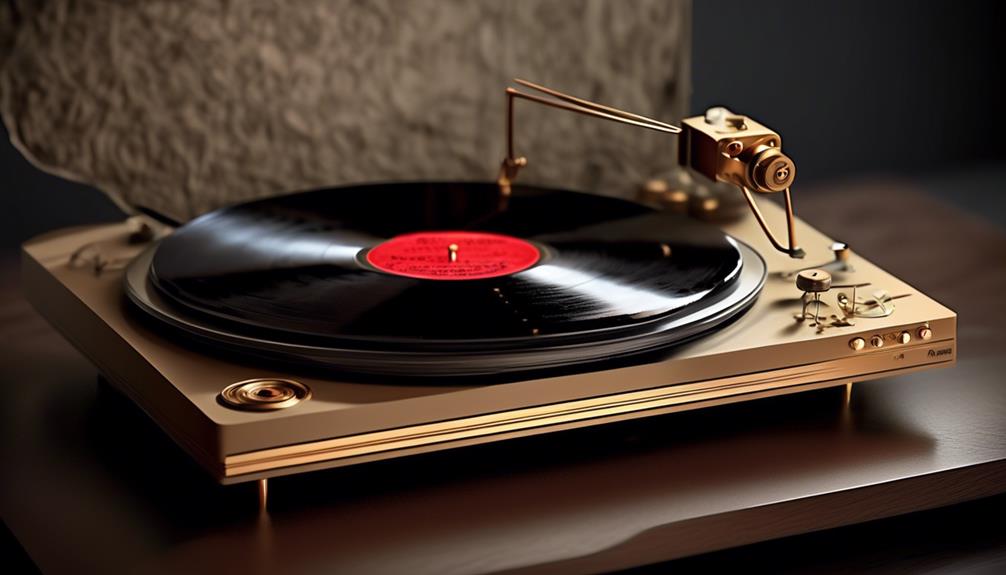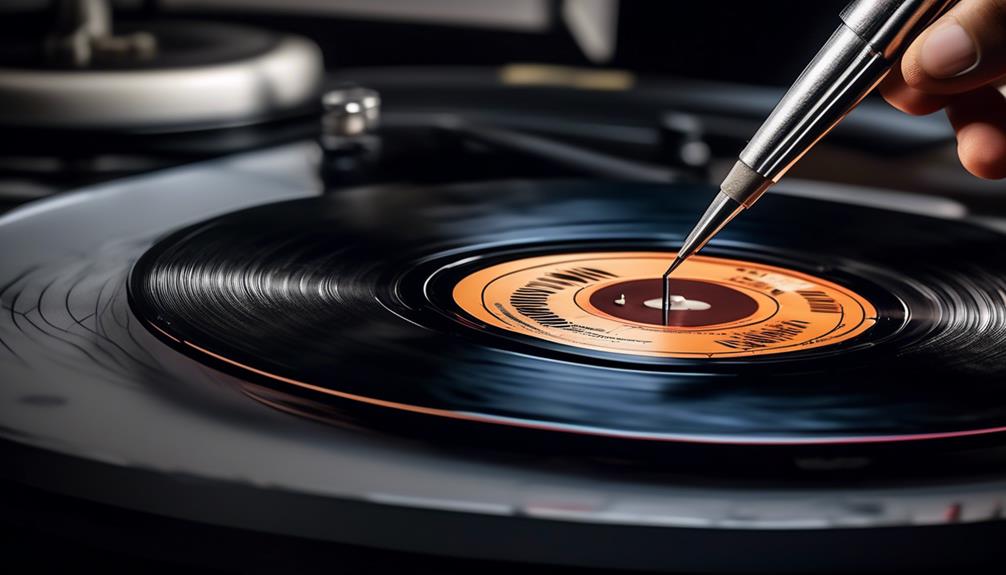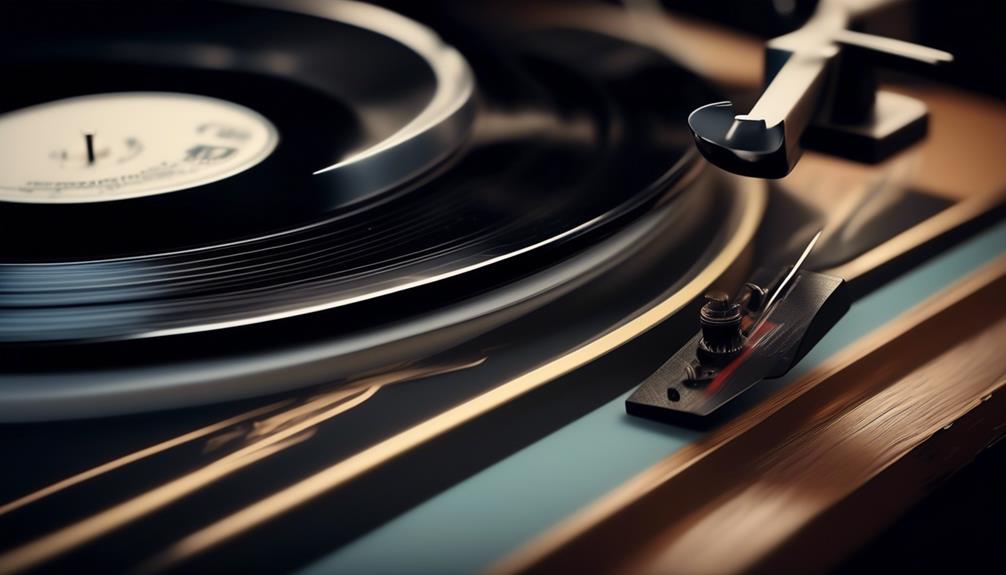You’ve just purchased your first vinyl record, and you’re excited to play it and enjoy the warm, nostalgic sound. But hold on – should you start the record with the needle down?
There's been quite a bit of debate on this topic, and it's not as straightforward as it may seem. Some argue that starting the turntable first is the way to go, while others swear by the needle-down approach.
It turns out there are valid points on both sides, and the decision may depend on various factors. Let's explore the potential impact of starting with the needle down and how it could affect your vinyl experience.
Key Takeaways
- Starting with the needle down reduces the risk of damage to the needle and record grooves, ensuring proper alignment and improved sound quality.
- Placing the needle directly onto the vinyl can cause stress and damage, so starting the turntable spinning first reduces the risk of skipping or jumping.
- Proper needle placement, including gently lowering the stylus onto the record surface and ensuring correct turntable speed, enhances the overall record playing experience and maximizes the lifespan of records.
- Factors such as turntable speed, tracking force, and record cleanliness can affect record wear, so proactive measures should be taken to preserve records and maintain optimal sound quality.
The Impact of Starting With the Needle Down

Starting with the needle down significantly reduces the risk of potential damage to the needle and record grooves in the event of accidental platter movement. This simple practice can have a substantial impact on the longevity and performance of your record player.
By starting with the needle down, the turntable is allowed to reach the correct speed before the needle touches the record. This ensures proper alignment and ultimately leads to an improved sound quality. Additionally, it reduces the risk of hearing annoying variations in speed and helps prevent sudden movements that can cause the needle to skip or jump, preserving the delicate grooves on your records.
For those with audiophile cartridges, the impact of starting with the needle down is even more pronounced. These sensitive cartridges require extra caution, making it beneficial to start with the needle down to minimize wear and tear on the record. Moreover, this practice also preserves the longevity of the turntable motor by avoiding unnecessary stress.
Potential Wear and Tear on Records

When initiating the turntable, allowing the record to reach the correct speed gradually is crucial for minimizing wear and tear on the grooves. Placing the needle directly onto the vinyl record can cause unnecessary stress and potential damage to both the record and the needle. By starting the turntable spinning first, the needle has time to align with the edge of the record, reducing the risk of sudden movements that can lead to skipping or jumping.
This method not only preserves the longevity of the turntable motor but also ensures that the delicate grooves of the vinyl record aren't subjected to abrupt and potentially damaging forces. Additionally, for those using delicate audiophile cartridges, taking the precaution of allowing the turntable to reach the correct speed before placing the needle can prevent potential wear and tear on the grooves, as these cartridges are more sensitive and require extra care.
Ultimately, by patiently allowing the record to reach the correct speed before placing the needle, the risk of wear and tear on the vinyl record is significantly reduced, preserving the quality and longevity of both the record and the needle.
Proper Needle Placement for Playing
To ensure proper needle placement for playing a vinyl record, it is essential to gently lower the stylus onto the record surface, ensuring the turntable is at the correct speed before placement. When playing the record, it is important to consider the proper needle placement to avoid potential damage and ensure optimal sound quality. The table below outlines the key considerations for proper needle placement to enhance the overall record playing experience.
| Key Considerations for Proper Needle Placement | Description |
|---|---|
| Gradual Speed Adjustment | Starting the turntable spinning first allows the record to reach the correct speed gradually, reducing the risk of hearing annoying variations in speed. |
| Protection from Wear and Tear | Proper needle placement prevents potential damage to the needle and record grooves, reducing wear and tear on the record by minimizing the risk of scratching during placement. |
| Time Efficiency | Placing the needle on the record first saves time by eliminating the need to wait for the turntable to reach the correct speed, providing immediate playback without any delay. |
Understanding the importance of proper needle placement is crucial for maximizing the lifespan of records and ensuring an optimal listening experience. By incorporating these considerations, enthusiasts can effectively enhance the way records work and prolong their enjoyment of vinyl music.
Factors Affecting Record Wear

Factors affecting record wear encompass various elements, including turntable speed, tracking force, record cleanliness, needle quality, and record material composition. These factors play a crucial role in maintaining the longevity of your vinyl records and preserving their sound quality.
- Turntable speed:
- Incorrect speed can cause slippage, leading to wear near the edge of the record.
- High-speed variations can cause the needle to skip, resulting in rapid wear in specific areas.
- Tracking force:
- Excessive force can cause the needle to dig into the grooves, accelerating wear.
- Insufficient force may lead to loss of contact, causing wear on the edges of the grooves.
- Record cleanliness:
- Dust and debris can cause scratches and groove damage, especially near the locking groove.
- Contaminants can force the needle to track improperly, leading to uneven wear patterns.
Considering these factors is crucial for minimizing record wear and ensuring that your vinyl collection remains in optimal condition. By understanding the impact of turntable speed, tracking force, and record cleanliness, you can take proactive measures to preserve your records and enjoy high-fidelity sound reproduction for years to come.
Best Practices for Preserving Vinyl
Preserving vinyl records requires careful consideration of best practices to minimize wear and maintain optimal sound quality, building upon the factors affecting record wear discussed previously.
When handling vinyl records, it's crucial to adopt proper techniques to ensure longevity and pristine audio reproduction. One of the fundamental best practices for preserving vinyl is the correct placement of the needle on the record.
Placing the needle near the center of the record is essential to minimize wear and distortion. Gently dropping the needle at the correct place prevents unnecessary scratching and damage to the grooves. Additionally, ensuring that the turntable is at the correct speed before placing the needle on the record is crucial for preserving the vinyl.
To maintain the integrity of vinyl records, it's imperative to handle them with care and precision. Properly placing the needle on the record not only safeguards the grooves from wear but also contributes to optimal sound quality.
Frequently Asked Questions
Where Do You Put the Needle to Start a Record?
We position the needle on the starting point of the vinyl record to initiate the spinning motion on the turntable. The starting position is crucial for preserving the record grooves and ensuring a smooth playback.
Placing the needle accurately on the record player is essential to maintaining the integrity of the vinyl and preventing unnecessary wear and tear. It's important to handle the needle with care to avoid damaging the grooves.
When Playing a Record Where Do You Start?
When playing a record on a record player, the starting position is crucial. Proper technique involves carefully placing the needle on the vinyl record while ensuring the turntable is at the correct speed.
This needle placement is essential for avoiding damage to the record grooves. It's important to be mindful of potential risks, such as scratching or misalignment, and to use cueing mechanisms to ensure a smooth start for the record.
Do Record Player Needles Wear Down?
Yes, record player needles do wear down over time. Proper needle maintenance is crucial for record longevity and vinyl preservation. Regular stylus care includes cleaning and inspection for any signs of wear or damage.
It's essential to replace the needle when necessary to avoid potential damage to both the record and the stylus. Monitoring the condition of the needle is critical for ensuring optimal playback quality and protecting your vinyl collection.
Is It Bad to Leave the Needle on the Record?
Leaving the needle on the record can cause wear and tear, affecting needle care and vinyl preservation.
It's important to prioritize turntable etiquette and best practices to ensure record player longevity and durability.
Proper maintenance and storage are crucial for preserving your vinyl collection.
Following these guidelines won't only extend the life of your equipment but also maintain the quality of your records for years to come.
Conclusion
In conclusion, while starting a record with the needle down may save time and allow for quick sampling, it can potentially cause wear and tear on the record grooves and the needle.
It's best to start the turntable spinning first to ensure the correct speed and proper alignment, ultimately preserving the quality of the record and stylus.
By following best practices for playing and preserving vinyl, you can enjoy your records for years to come.










